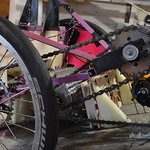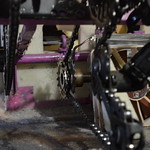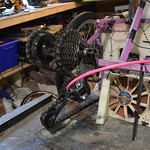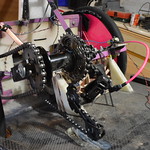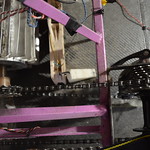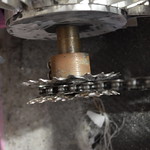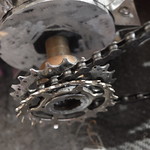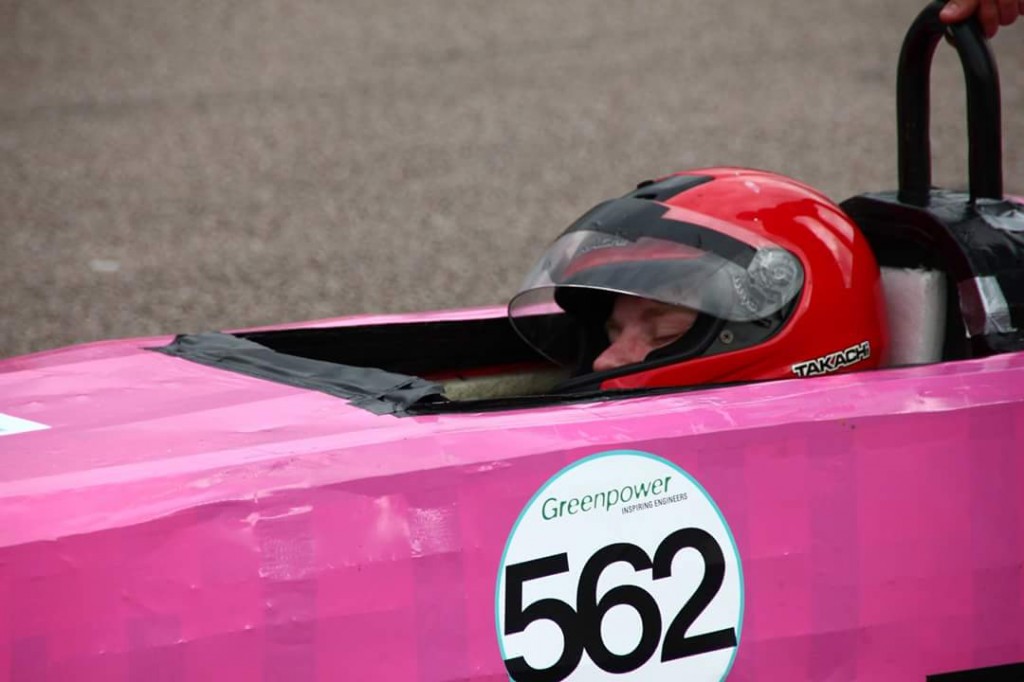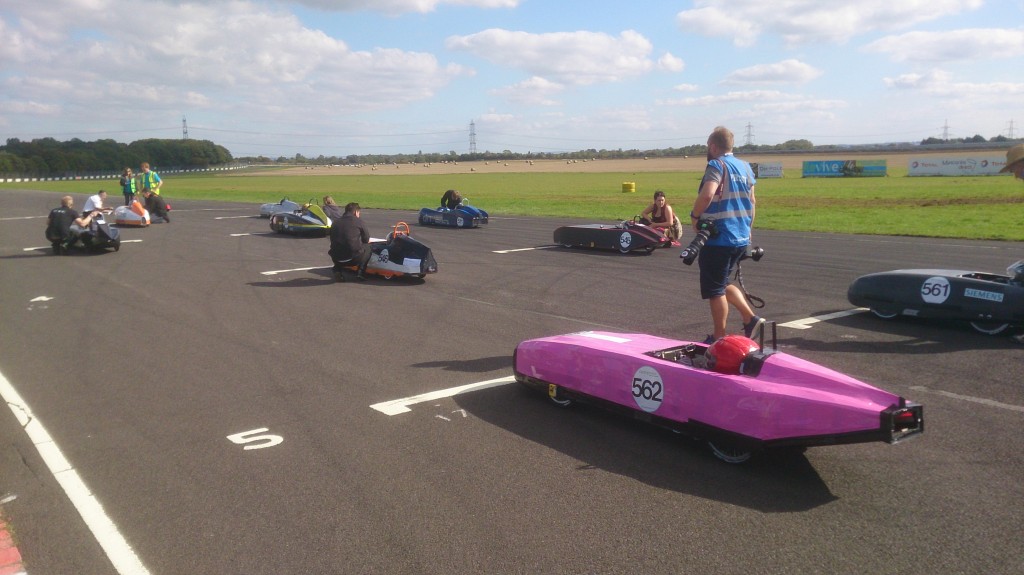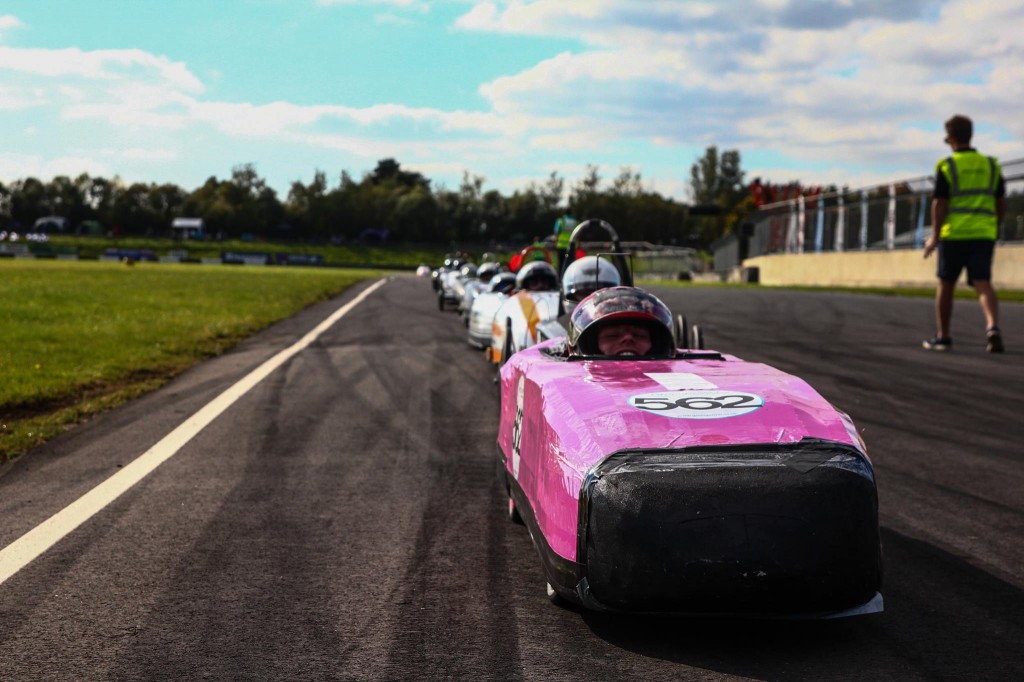We were back on the camping for Dunsfold, and Saturday was unprecedented – we were packed and ready to go 2 hours ahead of schedule, leaving us with absolutely no idea on what to do with ourselves. As we I would soon find out, checking that I’d remembered all the bits of my tent would have been a fine start.
The run down to Dunsfold went smoothly, with Electric 2Galoo successfully remaining on the roof of the SAAB. The ‘low slung sports wagon’ didn’t enjoy the road into the campsite, but it managed all the same. Having assembled my poleless tent using some cable ties, a van and my ingenuity, the campsite was set up, and we headed off to the local pub for some well earned grubs and a pint or three.
After a thankfully windless night, we left the campsite miraculously on time, and headed off for the circuit. We (nearly literally) bumped into the greenpower wombles towing a selection of portaloos when we got to the track – the rest of the world had been covered by a thick blanket of fog, which managed to lift itself just in time for practice.
Our first puncture of the day somehow managed to occur getting 2galoo off the roof of the wagon, causing some early morning consternation before scruiteneering. A quick change from Ian saw us get in the queue to have the car checked in plenty of time, and we had passed with plenty of time to go before practice started – in fact we even had time to walk the track, spotting the large landing lights that really needed to be avoided.
The second puncture of the day occurred almost immediately upon leaving the pitlane for our first practice lap. Somehow, even with a puncture, Ian set what would turn out to be the 13th fastest practice lap! We got the car back in, and changed the tyre for a second time, before getting getting back to the pitlane, hoping to collect some useful data before the end of the session.
Unfortunately, on the second corner, the jolt of running over a landing light caused a steering component to shear (having probably been overstressed after running around for 5 laps with a puncture). On getting the car back on the recovery wagon, we discovered that the failure was not something we would be able to fix without a welder.
A frantic dash up and down the paddock revealed that no one had bought any welding gear with them – the best offer we had was a soldering iron, which probably would not have done the trick! There’s no way we could go racing without getting that component fixed, so it was beginning to look like we’d be going home early. We were just about to give up and offer our assistance to Driven, when Jeremy pointed out that we had driven past an industrial estate on the way into the circuit. With 90 minutes to go before the race, if we could find someone who would lend us a welder, we could feasibly get the car fixed up and ready in time for the start.
In the end it took us about 30 seconds of searching before we bumped into Andy, who was doing a bit of catch up work installing a new clutch to a Golf in his workshop. He kindly offered to weld our bracket back together, and even added a very tidy (and much stronger) reinforcement, which would hopefully prevent any recurrence of the failure. Many thank yous and a dash back to the paddock, and Electric 2Galoo was back on 4 wheels.
We were the last car that made it to the grid in time for the start, having taped the bodywork down and wedged Ian in as quickly as possible. Ian didn’t really know the racing lines, neither of us knew if the car would survive mechanically, and we had no idea how much power we’d be using over the course of a lap. It was a stab in the dark (thankfully not in the fog as well though)!
With a few steady laps to get the lay of the land, 2galoo settled into 4th place, behind Jet, Reprobation and F-eV, but ahead of Rotary Racer and (most importantly) Project E. If someone had offered to the finish the race then, I would probably have taken their arm off!
The first 30 minutes of the race saw brilliant consistence from car and driver, managing 17 consecutive laps within a 2 second window. It was towards the end of this stint that F-eV began to start slowing down, and the gap between us and 3rd started to decrease. With 20 minutes to go, we were right behind them, and it was obvious from the noises at the rear end of F-eV that they’d developed a slight issue, but not one that was dramatically slowing them down.
Frantic discussions were in progress in the JLR Driven camp about retiring the car to save it for Aintree and Castle Combe, when Reprobation pulled off into the pit lane from the lead. (I haven’t even mentioned the excitement at the front! Reprobation had had the pace to overtake Jet, and looked like it might be able to hold on for the rest of the hour). This promoted F-eV to 2nd place – a position that would move them 2 points clear of Reprobation and Silesian in the overall championship if they could hold onto it. This made the decision for the team – take the risk and try to make it to the end of the race.
A few laps later, Electric 2galoo sailed past the ailing F-eV, into 2nd place. Ian wisely reduced the pace at this point to conserve power – there was little chance of catching Dave, so all we had to do was stay ahead of F-eV… or so we thought. Rotary Race began to catch up, having barely suffered any speed drop off at all – overtaking first F-eV and then Electric 2galoo.
A podium finish would have been plenty after the morning we’d had (and with all the bits of the car that really hadn’t been optimised yet), but fate intervened again, and with time for only a couple of laps left on the clock, Rotary Racer also pulled off the track with a puncture, promoting us back into 2nd place.
The final bit of icing on the cake was managing to unlap ourselves with a few minutes remaining! I don’t care how easy Dave was taking it, it’s still pretty satisfying to see your car go past the dominant force for the last few years. What’s more, it saw us finish the race on the same lap as Jet (and at one of the shortest circuits), something that I don’t remember having achieved before.
We were delighted also to receive the ‘Spirit of Greenpower’ award in the prize giving ceremony, it really did top off the day for us! Many thanks to everyone that gave us a hand, advice or just some kind words when all looked to be going wrong, we wouldn’t have managed without it!
Elsewhere in the field, REC-349 really got into its stride, finishing in a season’s best of 4th, and beating both of its big brothers. Its lap times were super consistent, showing good aerodynamic efficiency and power management – maybe it could/should have been going even faster and threatening F-eV.
There was great news also for EMF Racing, scoring their first points of the season, after we had some close racing with them at Bedford, where they just missed out in 9th.
A massive well done to the Arthur Terry School for a cracking performance to win the kit car race in F24 – they managed a 90 minute race with driver changes at a high average speed than the kit cars competing in F24+ did! I’ve supported Greenpower at a couple of events in the NEC where both the pupils and supervisors have been in attendance – the kids really know their stuff, and it’s a pleasure to talk to them about the hard work they put into their car, so I love seeing them do well!
Congratulations to Rotary Racer for winning both F24 races, I hope it makes up a small amount for the puncture in F24+, and of course, well done to Dave for a well managed victory in F24+. Now please stop keeping me on tenterhooks and get Jet 2.0 finished!
Next Stop for us is Aintree… and I think we’re meant to be leaving right about now!
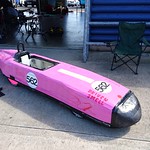

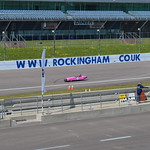

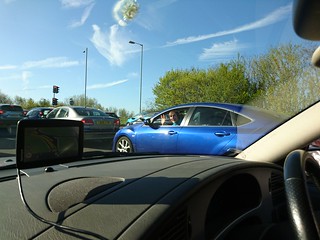
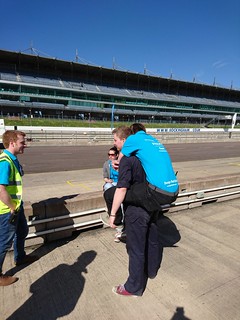

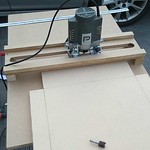
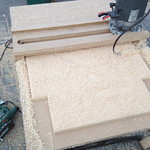

![IMG_20160505_193203[1] IMG_20160505_193203[1]](https://farm8.staticflickr.com/7389/26576178890_7205b4cb20_q.jpg)
![IMG_20160505_193137[1] IMG_20160505_193137[1]](https://farm8.staticflickr.com/7150/26576178610_53cfd546a2_q.jpg)
![IMG_20160505_193144[1] IMG_20160505_193144[1]](https://farm8.staticflickr.com/7085/26576178720_a272314dbb_q.jpg)
![IMG_20160505_193102[1] IMG_20160505_193102[1]](https://farm8.staticflickr.com/7343/26576179540_828b033cd9_q.jpg)
![received_10154805025717598[1] received_10154805025717598[1]](https://farm8.staticflickr.com/7799/26755190442_14187232c0_q.jpg)
![received_10154805025462598[1] received_10154805025462598[1]](https://farm8.staticflickr.com/7638/26576178370_095288a33a_q.jpg)
![IMG_20160505_193112[1] IMG_20160505_193112[1]](https://farm8.staticflickr.com/7603/26815128946_24faffeabd_q.jpg)
![IMG_20160505_193054[1] IMG_20160505_193054[1]](https://farm8.staticflickr.com/7304/26815128836_8479e2ff8c_q.jpg)
